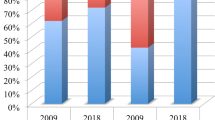Abstract
Metallurgy/materials education will continue to evolve to encompass, in an intellectually unified way, the full range of structural and functional materials. Computation, information, and other advanced sciences and technologies will assume increasing roles in materials education, as will distance and continuing education. The advantages of the changes will be many ... to the graduates, to emerging industries, and to the traditional metallurgical industries seeking productive, creative young engineers as employees. The need for continuing change in our metallurgy/materials departments is now no less if we are to attract the best young people into our field in the numbers and to best serve the needs of industry.
Similar content being viewed by others
References
M.C. Flemings: Ann. Rev. Mater. Sci., Annual Reviews Inc., Palo Alto, CA, 1999, vol. 29, pp. 1–23.
M.C. Flemings and R.W. Cahn: Acta Mater., 2000, vol. 48, pp. 371–83.
M.C. Flemings and S. Suresh: unpublished research.
M.B. Bever: Mettalurgy and Materials Science at MIT: 1865–1988, MIT, Cambridge, MA, 1988.
T.A. Rickard: The History of American Mining, McGraw-Hill, New York, NY, 1932.
A History of Technology, v. 51, C. Singer, E.J. Holmyard, R. Hall, and T.I. Williams, eds., Clarendon Press, Oxford, United Kingdom, 1958.
P.H. Spitz: Petrochemicals, The Rise of an Industry, John Wiley & Sons, New York, NY, 1988.
Historical Statistics of the United States, Colonial Times to 1970, United States Department of Commerce, Bureau of the Census, United States Government Printing Office, Washington, DC.
Materials Science and Engineering for the 1990’s, National Research Council, National Academy Press, Washington, D.C., 1989.
The New Materials Society, v. 1, New Materials Markets and Issues, United States Bureau of Mines, United States Government Printing Office, Washington, DC., 1990.
M.E. Fine and H.L. Marcus: Ann. Rev. Mater. Sci., 1994, vol. 24, pp. 1–17.
D.M. Hart and L.M. Branscomb: Nature, 2000, vol. 407, pp. 561–62
Lyle Schwartz: AFOSR/NA, Arlington, VA, private communication.
Materials Science and Engineering: Forging Stronger Links to Users, National Research Council, National Materials Advisory Board, National Academy Press, Washington, D.C., 1999.
F.E. Wylie: MIT in Perspective, Little Brown and Company, Boston, MA, 1975.
H.M. Howe: Iron, Steel, and Other Alloys, Sauveur and Whiting, Boston, MA, 1903.
Additional information
Merton C. Flemings received his S.B. degree from MIT in the Department of Metallurgy in 1951. He received his S.M. and Sc.D. degrees, also in Metallurgy, in 1952 and 1954, respectively. From 1954 to 1956, he was employed as Metallurgist at Abex Corporation (Mahwah, NJ), and in 1956 returned to MIT as Assistant Professor. He was appointed Associate Professor in 1961 and Professor in 1969. In 1970, he was appointed Abex Professor of Metallurgy. In 1975, he became Ford Professor of Engineering, and, in 1981, Toyota Professor of Materials Processing. He established and was the first director of the Materials Processing Center at MIT in 1979. He served as Head, Department of Materials Science and Engineering, from 1982 to 1995 and thereafter returned to full-time teaching and research as Toyota Professor. He was Visiting Professor at Cambridge University in 1971, Tokyo University in 1986, and Ecole des Mines in 1996. In 1999, he was appointed Co-Director of the Singapore-MIT Alliance, a major distance educational and research collaboration among MIT and two Singaporean universities.
Professor Flemings’ research and teaching concentrate on engineering fundamentals of materials processing and on innovation of materials processing operations. He is active nationally and internationally in strengthening the field of Materials Science and Engineering and in delineation of new directions for the field. He is a member of the National Academy of Engineering and of the American Academy of Arts and Sciences. He is author or co-author of 300 papers, 26 patents, and 2 books in the fields of solidification science and engineering, foundry technology, and materials processing. He has worked closely with industry and industrial problems throughout his professional career and currently serves on a number of corporate and technical advisory boards.
He received the Simpson Gold Medal from the American Foundrymen’s Society in 1961, the Mathewson Gold Medal of TMS in 1969, and the Henry Marion Howe Medal of ASM International in 1973 and became a Fellow, ASM International, in 1976. In 1977, he was awarded the Henri Sainte-Claire Deville Medal by the Societe Francaise de Metallurgie. In October 1978, he received the Albert Sauveur Achievement Award from ASM INTERNATIONAL. In 1980, he received the John Chipman Award from AIME. In 1984, he was elected an honorary member of the Japan Foundrymen’s Society and, in 1985, received the James Douglas Gold Medal from the AIME. The Italian Metallurgical Association awarded him the Luigi Losana Gold Medal in 1986, and he was elected honorary member of The Japan Iron and Steel Institute in 1987. He was elected a TMS Fellow in 1989. In 1990, he received the TMS Leadership Award, and the Henry Marion Howe Medal and delivered the Edward DeMille Campbell Memorial Lecture of ASM INTERNATIONAL. In 1991, he received the Merton C. Flemings Award from Worcester Polytechnic Institute. Sigma Alpha Mu elected him a Distinguished Life Member in 1992. In 1993, he received the TMS 1993 Bruce Chalmers Award and was elected Councillor of the Materials Research Society. He was elected to the ASM INTERNATIONAL Board of Trustees in 1994. He received the Acta Metallurgica J. Herbert Holloman Award in 1997 for “contributions to materials technology that have had major impact on society.” Also in 1997 he was appointed David Turnbull Lecturer of the Materials Research Society for “outstanding contributions to understanding materials phenomena and properties.” He received the Educator Award of TMS in 1999, received the FMS (Federation of Materials Societies) National Materials Advancement Award in late 1999, and delivered the ASM and TMS Distinguished Lecture in Materials and Society in 2000.
Rights and permissions
About this article
Cite this article
Flemings, M.C. Why materials science and engineering is good for metallurgy. Metall Mater Trans B 32, 197–204 (2001). https://doi.org/10.1007/s11663-001-0043-5
Issue Date:
DOI: https://doi.org/10.1007/s11663-001-0043-5




